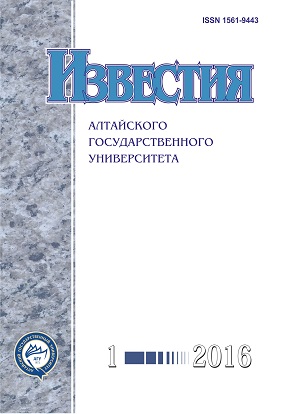Statistical Analysis of Hydrophysical Parameters of Closed Lakes
Abstract
Warming of the climate of the south of Western Siberia manifests in water content reduction of lakes in the territory, particularly closed lakes. Accuracy and reliability of calculated values are of utmost importance for quality evaluation of calculated hydrological characteristics over actual data of hydrometeorological survey (in particular, water and liquid precipitation levels). The goal of this study is to evaluate the probability of water level changes (increasing, decreasing) and, further, predict spring floods on the basis of hydrometeorological survey data. Empirical and theoretical lake water level distribution functions for two observation periods (2013–2014 and 2014–2015) have been obtained, and statistical analysis of prediction accuracy of hydrological characteristics is performed. Root mean square errors for predicted hydrological characteristics are estimated using deviations between theoretical (predicted) and empirical dependencies.
DOI 10.14258/izvasu(2016)1-12
Downloads
Metrics
References
Beatrix E. Beisner, Maria Lorena Longhi Spatial overlap in lake phytoplankton: Relations with environmental factors and consequences for diversity//Limnology and Oceanography. -2013. -№ 58 (4).
Клавен А.Б., Копалиани З.Д. Экспериментальные исследования и гидравлическое моделирование речных потоков и руслового процесса. -СПб., 2011.
Фролова Н.Л., Киреева М.Б., Джамалов Р.Г., Рец Е. П., Телегина Е. А. Изменение водного режима и сезонного стока рек и их влияние на экстремальные гидрологические ситуации//Фундаментальные проблемы воды и водных ресурсов: труды IV Всеросс. науч. конф. с междунар. участием. -М., 2015.
Studies in Mountain Hydrology/ed. A. Herrmann, U. Schroder. -IHP/HWRP Berichte, Heft 2. -Koblenz, 2004.
Кучмент Л.С. Речной сток (генезис, моделирование, предвычисление). -М., 2008.
World Meteorological Organization. Guide to Hydrological Practices. Volume II. Management of Water Resources and Application of Hydrological Practices//WMO. -No. 168. Sixth ed. -Geneva, 2009.
Зуев В.В., Суторихин И.А., Кураков С.А., Залае-ва У И. Измерительный комплекс для регистрации параметров окружающей среды на водном объекте//Ползунов-ский вестник. -2014. -№ 2.
Барышникова О.Н., Харламова Н.Ф., Козыре ва Ю.В., Ненашева Г.И. Физико-географическая характеристика комплексного учебно-научного стационара Алт-ГУ «Озеро Красилово»: учебное пособие. -Барнаул, 2013.
Рождественский А.В., Лобанов А.Г. Методические рекомендации по определению расчетных гидрологических характеристик при наличии данных гидрометрических наблюдений. -СПб., 2009.
Определение расчетных гидрологических характеристик: пособие П1-98 к СНиП 2.01.14-83. -Минск, 2000.
Izvestiya of Altai State University is a golden publisher, as we allow self-archiving, but most importantly we are fully transparent about your rights.
Authors may present and discuss their findings ahead of publication: at biological or scientific conferences, on preprint servers, in public databases, and in blogs, wikis, tweets, and other informal communication channels.
Izvestiya of Altai State University allows authors to deposit manuscripts (currently under review or those for intended submission to Izvestiya of Altai State University) in non-commercial, pre-print servers such as ArXiv.
Authors who publish with this journal agree to the following terms:
- Authors retain copyright and grant the journal right of first publication with the work simultaneously licensed under a Creative Commons Attribution License (CC BY 4.0) that allows others to share the work with an acknowledgement of the work's authorship and initial publication in this journal.
- Authors are able to enter into separate, additional contractual arrangements for the non-exclusive distribution of the journal's published version of the work (e.g., post it to an institutional repository or publish it in a book), with an acknowledgement of its initial publication in this journal.
- Authors are permitted and encouraged to post their work online (e.g., in institutional repositories or on their website) prior to and during the submission process, as it can lead to productive exchanges, as well as earlier and greater citation of published work (See The Effect of Open Access).








